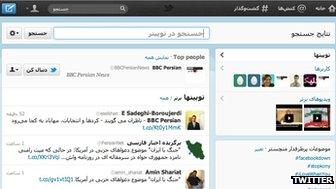Twitter Arabic, Farsi, Hebrew and Urdu version launch
-
Published

Twitter has rolled out versions of its site in right-to-left languages for the first time.
The micro-blog service is now available in Arabic, Farsi, Hebrew and Urdu.
It said 13,000 volunteers helped translate its menu options and support pages into the languages.
Experts said the move should help more "ordinary people" make use of the service, both to hold politicians to account and to tweet about their everyday life.
Twitter's blogsaid the translation volunteersincluded a Saudi blogger, an IT professional in Iran, the co-founders of the grassroots #LetsTweetInArabic campaign and a BBC journalist.
"Some of these volunteers live in regions where Twitter is officially blocked," it said.
"Their efforts speak volumes about the lengths people will go to make Twitter accessible and understandable for their communities."
Block busting
The service was blocked by authorities in Iran ahead of 2009's presidential elections and in Egypt during the 2011 protests that led to the ousting of President Hosni Mubarak.
Pakistan also temporarily prevented access to the site in 2010 citing "sacrilegious content" as the cause. The action followed one user's suggestion that members should upload pictures of the Prophet Muhammad which is not allowed under Islam.
However, some users were able to circumvent the bans by connecting to the net via proxy servers or using third-party smartphone apps that were not affected.
Annabelle Sreberny, professor of global media and communications at London's School of Oriental and African Studies, acknowledged that social networks and blogs had proved useful to protesters in the Middle East and Asia, but cautioned against overstating Twitter's significance.
"Twitter has been overhyped in its role in the [Iranian] 2009 stolen election and in the Tunisian uprising that then overthrew Ben Ali," she told the BBC.
"It is just one among a range of tools and platforms that people use."
However, the professor added that tailoring the service to local audiences would help it become more influential.
"I think the parallel would be the making available of tools to help people blog in Persian in 2002-3 by Hossein Derakshan. His manual on how to blog in the language helped trigger a huge boom in Persian voices on the internet."
Technical challenge
Twitter said that integrating the use of right-to-left content had posed it a "unique" challenge.
It noted that some tweets still needed to include left-to-right material to allow users to mention subject hashtags or other members' account names written in other languages.
To address this it said its engineers had built new tools for the site to ensure the text and numbers would still look normal.
The firm said it was now available in 28 languages and would announce an appeal for people to help further increase that number at an unspecified date.
-
-
Published7 March 2012
-
-
-
Published27 January 2012
-
-
-
Published21 May 2010
-